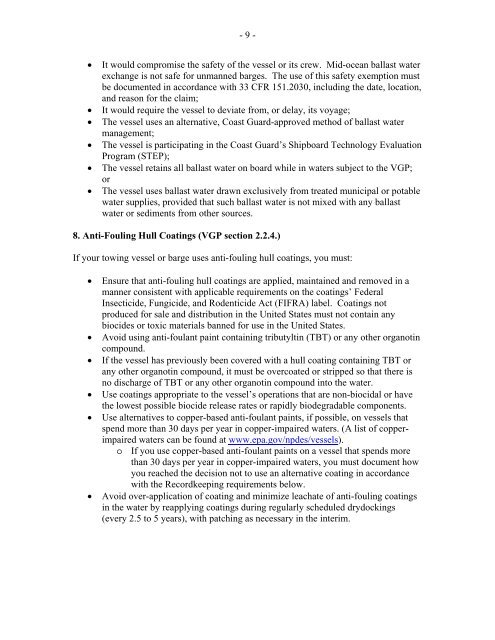AWO Recommended Practice Guide - The American Waterways ...
AWO Recommended Practice Guide - The American Waterways ...
AWO Recommended Practice Guide - The American Waterways ...
You also want an ePaper? Increase the reach of your titles
YUMPU automatically turns print PDFs into web optimized ePapers that Google loves.
- 9 -It would compromise the safety of the vessel or its crew. Mid-ocean ballast waterexchange is not safe for unmanned barges. <strong>The</strong> use of this safety exemption mustbe documented in accordance with 33 CFR 151.2030, including the date, location,and reason for the claim;It would require the vessel to deviate from, or delay, its voyage;<strong>The</strong> vessel uses an alternative, Coast Guard-approved method of ballast watermanagement;<strong>The</strong> vessel is participating in the Coast Guard’s Shipboard Technology EvaluationProgram (STEP);<strong>The</strong> vessel retains all ballast water on board while in waters subject to the VGP;or<strong>The</strong> vessel uses ballast water drawn exclusively from treated municipal or potablewater supplies, provided that such ballast water is not mixed with any ballastwater or sediments from other sources.8. Anti-Fouling Hull Coatings (VGP section 2.2.4.)If your towing vessel or barge uses anti-fouling hull coatings, you must:Ensure that anti-fouling hull coatings are applied, maintained and removed in amanner consistent with applicable requirements on the coatings’ FederalInsecticide, Fungicide, and Rodenticide Act (FIFRA) label. Coatings notproduced for sale and distribution in the United States must not contain anybiocides or toxic materials banned for use in the United States.Avoid using anti-foulant paint containing tributyltin (TBT) or any other organotincompound.If the vessel has previously been covered with a hull coating containing TBT orany other organotin compound, it must be overcoated or stripped so that there isno discharge of TBT or any other organotin compound into the water.Use coatings appropriate to the vessel’s operations that are non-biocidal or havethe lowest possible biocide release rates or rapidly biodegradable components.Use alternatives to copper-based anti-foulant paints, if possible, on vessels thatspend more than 30 days per year in copper-impaired waters. (A list of copperimpairedwaters can be found at www.epa.gov/npdes/vessels).o If you use copper-based anti-foulant paints on a vessel that spends morethan 30 days per year in copper-impaired waters, you must document howyou reached the decision not to use an alternative coating in accordancewith the Recordkeeping requirements below.Avoid over-application of coating and minimize leachate of anti-fouling coatingsin the water by reapplying coatings during regularly scheduled drydockings(every 2.5 to 5 years), with patching as necessary in the interim.















